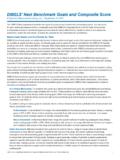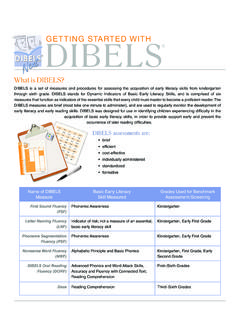Transcription of DIBELS Next Benchmark Goals and Composite Score
1 DIBELS is a registered trademark of Dynamic Measurement Group, Inc. next Benchmark Goals and Composite Score Dynamic Measurement Group, Inc. / September 12, 2016 The DIBELS next assessment provides two types of scores at each Benchmark assessment period: a) a raw Score for each individual measure and b) a Composite Score (the DIBELS Composite Score or DCS). Each of the scores is interpreted relative to Benchmark Goals and cut points for risk to determine if a student s Score is at or above the Benchmark , below the Benchmark , or below the cut point for risk (well below the Benchmark ). Benchmark Goals and Cut Points for RiskDIBELS Benchmark Goals are empirically derived, criterion-referenced target scores that represent adequate reading skill for a particular grade and time of year. Benchmark Goals and cut points for risk are provided for the DIBELS Composite Score as well as for individual DIBELS measures.
2 Benchmark Goals are based on research that examined the predictive probability of a Score on a measure at a particular point in time, compared to later DIBELS measures and external measures of reading proficiency and achievement. (Additional information about the Benchmark Goals research is included in the DIBELS next Technical Manual, available from )A Benchmark goal indicates a level of skill at which students are likely to achieve the next DIBELS Benchmark goal or reading outcome. Thus, for students who achieve a Benchmark goal, the odds are in their favor of achieving later reading outcomes if they receive effective core reading , the cut points for risk indicate a level of skill below which students are unlikely to achieve subsequent reading Goals without receiving additional, targeted instructional support. For students who have scores below the cut point for risk, the probability of achieving later reading Goals is low unless intensive support is provided.
3 DIBELS next Benchmark Goals and cut points for risk provide three primary Benchmark status levels that describe students performance: a) At or Above Benchmark , b) Below Benchmark , and c) Well Below Benchmark . These levels are based on the overall likelihood of achieving specified Goals on subsequent DIBELS next assessments or external measures of reading achievement. At or Above Benchmark . For students who Score at or above the Benchmark goal, the overall likelihood of achieving subsequent reading Goals is approximately 80% to 90%. These students are likely to need effective core instruction to meet subsequent early literacy and/or reading Goals . Within this range, the likelihood of achieving subsequent Goals is lower for students whose scores are right at the Benchmark goal and increases as scores increase above the Benchmark (see Table 1).
4 To assist in setting ambitious Goals for students, the At or Above Benchmark level is subdivided into At Benchmark and Above Benchmark Benchmark . In the At Benchmark range, the overall likelihood of achieving subsequent early literacy or reading Goals is 70% to 85%. Some of these students, especially those with scores near the Benchmark , may require monitoring and/or strategic support on specific component Benchmark . In the Above Benchmark range, the overall likelihood of achieving subsequent early literacy and/or reading Goals is 90% to 99%. While all students with scores in this range will likely benefit from core support, some students with scores in this range may benefit from instruction on more advanced skills. Below Benchmark . Between the Benchmark goal and cut point for risk is a range of scores where students future performance is more difficult to predict.
5 For students with scores in this range, the overall likelihood of achieving subsequent early literacy/reading Goals is approximately 40% to 60%. These students are likely to need strategic support to ensure their achievement of future Goals . Strategic support generally consists of carefully targeted supplemental support in specific skill areas in which students are having difficulty. To ensure that the greatest number of students achieve later reading success, it is best for students with scores in this range to be monitored regularly to ensure that they are making adequate progress and to receive increased or modified support if necessary to achieve subsequent reading Goals . DIBELS is a registered trademark of Dynamic Measurement Group, Inc. Below Benchmark . For students who Score below the cut point for risk, the overall likelihood of achieving subsequent early literacy/reading Goals is low, approximately 10% to 20%.
6 These students are identified as likely to need intensive support. Intensive support refers to interventions that incorporate something more or something different from the core curriculum or supplemental support might entail: delivering instruction in a smaller group or individually, providing more instructional time or more practice, presenting smaller skill steps in the instructional hierarchy, providing more explicit modeling and instruction, and/or providing greater scaffolding and practice. Because students who need intensive support are likely to have individual needs, we recommend that their progress be monitored frequently and their intervention modified dynamically to ensure adequate progress. Table 1 summarizes the design specifications for achieving later reading outcomes and provides descriptions for the likely need for support for each of the Benchmark status levels.
7 It is important to note that while there is an overall likelihood for each Benchmark status level, within each level the likelihood of achieving later reading outcomes increases as students scores increase. This is illustrated in the first column of Table 1. Likelihood of Meeting Later Reading Goals and DIBELS next Benchmark StatusLikelihood of Meeting Later Reading GoalsBenchmark StatusBenchmark Status Including Above BenchmarkWhat It Means>99%95%90%80%70%60%55%50%45%40%30%2 0%10% <5%At or Above Benchmarkoverall likelihood of achieving subsequent early literacy Goals : 80% to 90%Above Benchmarkoverall likelihood of achieving subsequent early literacy Goals : 90% to 99%For students with scores in this range, the odds of achieving subsequent early literacy/reading Goals are very students likely need effective core instruction to meet subsequent early literacy/reading Goals .
8 Some students may benefit from instruction on more advanced Benchmarkoverall likelihood of achieving subsequent early literacy Goals : 70% to 85%For students with scores in this range, the odds are in favor of achieving subsequent early literacy/reading Goals . The higher above the Benchmark goal, the better the students likely need effective core instruction to meet subsequent early literacy/reading Goals . Some students may require monitoring and strategic support on specific component skills as Benchmarkoverall likelihood of achieving subsequent early literacy Goals : 40% to 60%Below Benchmarkoverall likelihood of achieving subsequent early literacy Goals : 40% to 60%For students with scores in this range, the overall odds of achieving subsequent early literacy/reading Goals are approximately even, and hard to predict.
9 Within this range, the closer students scores are to the Benchmark goal, the better the odds; the closer students scores are to the cut point, the lower the students likely need core instruction coupled with strategic support, targeted to their individual needs, to meet subsequent early literacy/reading Goals . For some students whose scores are close to the Benchmark goal, effective core instruction may be sufficient; students whose scores are close to the cut point may require more intensive Below Benchmarkoverall likelihood of achieving subsequent early literacy Goals : 10% to 20%Well Below Benchmarkoverall likelihood of achieving subsequent early literacy Goals : 10% to 20%For students with scores in this range, the overall odds of achieving subsequent early literacy/reading Goals are students likely need intensive support in addition to effective core instruction.
10 These students may also need support on prerequisite skills ( , below grade level) depending upon the grade level and how far below the Benchmark their skills addition of the Above Benchmark status level has not changed the Benchmark Goals . A Benchmark goal is still the point at which the odds are in the student s favor of meeting later reading Goals (approximately 60% likelihood or higher). The higher above the Benchmark goal the student scores, the better the odds. For students who are already at Benchmark , the Above Benchmark status level also provides a higher goal to aim for. Overall likelihood refers to the approximate percentage of students within the category who achieve later Goals , although the exact percentage varies by grade, year, and measure (see DIBELS next Benchmark Goals and Composite Score document).

